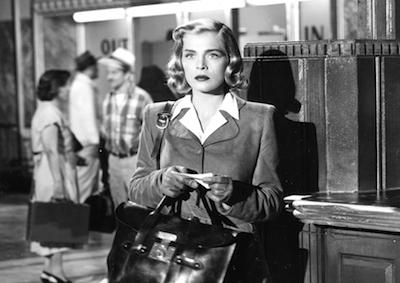After 17 highly successful years as one of MGM’s most successful producers (the Thin Man series, the Jeannette MacDonald & Nelson Eddy operettas, etc.), Hunt Stromberg left the studio to produce a series of smaller budget films with his own independent production company. Utilizing strong female leads and auteurs like Edgar G. Ulmer and Douglas Sirk, many of these Hunt Stromberg titles have slipped into the public domain (including Lady of Burlesque, 1943; The Strange Woman, 1946; etc). Adapted by author Roy Huggins from his novel that was serialized in the Saturday Evening Post, Too Late For Tears was one such production. It was also Stromberg’s last independent film before retiring in 1951.
Between his extensive and award-winning stint in the special effects department at Warner Bros. and directing a series of widely successful science fiction and adventure films throughout the 1950s and 1960s, Byron Haskin competently helmed a few noir titles in the late 1940s. When handed the script for Too Late For Tears, Haskin immediately thought of the sultry and alluring Lizabeth Scott whom he recently directed in I Walk Alone (1948). Unlike the previous film, where Scott took a back seat to the flamboyant performances of Burt Lancaster and Kirk Douglas, Too Late For Tears provides Scott with the meaty role of frustrated housewife Jane Palmer, whose married life careens out of control with murderous greed when a suitcase filled with $60,000 is accidentally “tossed” to her and husband Alan (played by Arthur Kennedy). Beyond the fantastically theatrical turn by Scott, the production highlights an exceedingly devious performance by another noir icon, Dan Duryea.
Although coolly received by audiences initially, this seemingly minor noir has gained quite a cult following in recent years. Modern audiences now recognize it as a darkly satisfying and atmospheric meditation on the covetous social and materialistic ambitions of postwar middle-class America. Eddie Muller of the Film Noir Foundation calls the film “the best unknown American film noir of the classic era.” —Todd Wiener
Director: Byron Haskin. Production: Streamline Pictures. Distribution: United Artists Corp. Producer: Hunt Stromberg. Screenwriter: Roy Huggins. Based on the novel Too Late for Tears by Roy Huggins. Cinematographer: William Mellor. Art Direction: James Sullivan. Editor: Harry Keller. Music: Dale Butts. Cast: Lizabeth Scott, Don DeFore, Dan Duryea, Arthur Kennedy, Kristine Miller. 35mm, b/w, 100 min.
Restored from the 35mm nitrate French dupe negative, a 35mm acetate reissue print and a 16mm acetate print. Laboratory services by Film Technology Company, Inc., Pacific Title & Art Studio, Simon Daniel Sound. Special thanks to: The Hollywood Foreign Press Association’s Charitable Trust (The HFPA Trust); Amy Turner—Southern Methodist University.






 Mobile Navigation
Mobile Navigation

